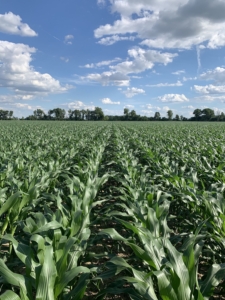AGRONOMIC UPDATE JUNE 10, 2023….Let it rain….
TOPICS FOR THIS UPDATE:
- Planting and Early Spring conditions….
- Temperatures & GDU accumulation
- What’s going on in my fields right now….
- Crop Water Use
- Rapid Growth Syndrome in Corn
- Insect Update
- Soybean Update
PLANTING AND EARLY SPRING CONDITIONS…..
2023 planting season started off very cold. The month of April was on the cold side with the only real period of warmth around April 17-20. May, however, saw warmer temperatures from about May 5 and on. As usual this all impacted emergence. The below photos show some of the potential issues that caused uneven emergence. The first photos show the impact of residue from harvest conditions last fall along with cold soil temperatures. The streaks are spreader issues from the combine. This field was planted right before a down turn in temperatures. Overall stand is good, but was uneven due to the residue. Considering the early cold temperatures at planting, corn stands are very good overall. Pioneer hybrids showed strong emergence and stand establishment. The last photo shows the difference on emergence between P1170AM and a 112 day competitor. Along with the genetics, Pioneer seed treatments give an extra boost. We are seeing very good early growth out of some of the new hybrids like P1164AM & P1170AM. As of today, the early planted corn (ie. April) looks best…
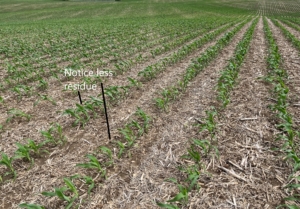
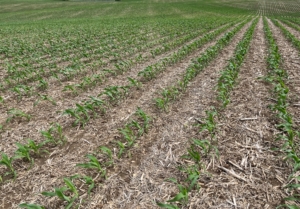
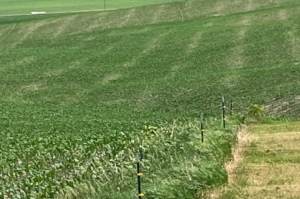

TEMPERATURES & GDU ACCUMULATION:
As of June 9th, we have accumulated approximately the following for Growing Degree Units in 2023:
Planting Date GDD’s2022 Average GDD Departure from average
April 17 756 629 +127 (+7-8 days)
April 26 712 570 +142 (+8 days)
May 9 656 506 +150 (+8 days)
As you can see from the above numbers, we are much ahead of the 30-year average. The corn crop is reflecting this as well as overall growth has been rapid. These numbers are a week ahead of 2022 as well. After a cold planting season, the crop has really ‘taken-off’. We are off to a ‘fast start’ which is usually a positive for yield…now, if we can just snag a good rain!
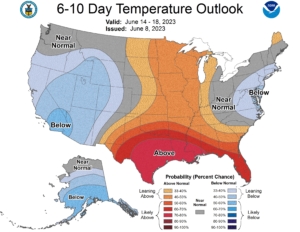
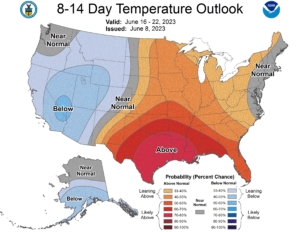
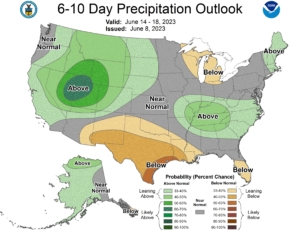
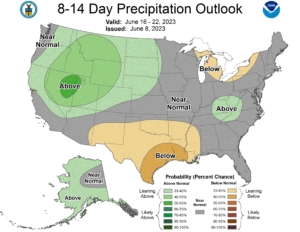
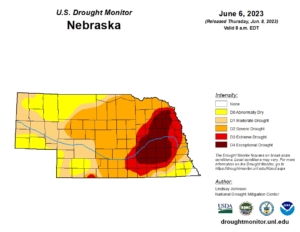
The above images are the temperature and precipitation forecasts for the next 7-14 days with the current drought monitor map for Nebraska. We have been much above normal temperatures for the past two weeks; however, it looks like we may potentially be cooling off somewhat over the next few days compared to the last few days. Average high temperatures so far in June have been 6-7 degrees above normal and average low temperatures are 2-4 degrees above normal. After a cooler weekend, temps are forecasted to be back in the 80’s. Hopefully the precip maps will turn out true and we will snag a good rain….some areas around us have received moisture the last two days. It’s a pattern where one is lucky or not….
WHAT’S GOING ON IN MY FIELDS RIGHT NOW?...
As mentioned above, overall corn stands are very good. The majority of the April planted crop is in the 7-8 leaf stage-of-growth and the May planting dates are 5-6 leaf…this is one week ahead of 2022. From V1-V10, corn gains a leaf collar about every 83 GDU’s…this will be about every 3 – 4 days with current forecasted conditions. This would put us in the July 10-15 time frame potentially, for tasseling.
- At V5, leaf and ear shoot initiation will be complete and a microscopically small tassel is initiated in the stem apex tip, or top of the growing point.
- At V6, the growing point and tassel will be above the soil surface and the stalk is beginning a period of greatly increased elongation.
- Determination of potential kernel rows around will be completed around V7 (range of V5-V8)…all fields are now is this stage….
- The corn root system is now rapidly transitioning to the main nodal root system. When hot temperatures occur following a cool spell, crop growth at this stage can be uneven. Areas of heavier residue will start to look shorter. It will take a little time for that to catch up.
- At V9, an ear shoot will develop from every above-ground node, except the las six to eight nodes below the tassel. Growth of most of the lower stalk ear shoots eventually slows, and only the upper one or two ear shoots will develop into a harvestable ear.
- At V10, the time between the appearance of new leaf stages will shorten….generally every 2-3 days.
- We are now heading into the rapid growth and accumulation of dry matter by the plant. The window for brittle snap will start to grow exponentially over the next few weeks.
- Watch temperatures as you are spraying post-herbicides on corn or beans over the next several days. When temps are in the 90’s and humidity is very low or high, the potential for crop response from post-application of herbicides will increase. It is not recommended to be spraying during the heat of the day if temps are in the low-to-upper 90’s…both for potential crop response and herbicide control.
CROP WATER USE
CROP STAGE OF GROWTH & ROOTING DEPTH:
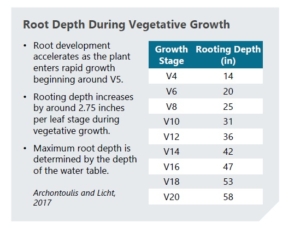 From the chart, you can see that average rooting depth for V6-V8 corn is approximately 20-25″, depending upon weather conditions, soil type and structure, etc. Currently the AquaSpy moisture probes are showing 12-24″ rooting depths across soil types and planting dates, so we are very much in the normal on rooting depth. However, soil moisture profile is low overall and it is now easier to pick out dryland corners, etc.
From the chart, you can see that average rooting depth for V6-V8 corn is approximately 20-25″, depending upon weather conditions, soil type and structure, etc. Currently the AquaSpy moisture probes are showing 12-24″ rooting depths across soil types and planting dates, so we are very much in the normal on rooting depth. However, soil moisture profile is low overall and it is now easier to pick out dryland corners, etc.
ET USAGE:
ET, or evapotranspiration, has been exceedingly high over the past week. Total ET from June 1-9 was 2.41 inches for our area for an average of .27in/day. Relative humidity over the past week has also been below normal with the increased temperatures, which increases overall ET rates. The above forecasts will see this trend slow down somewhat if cooler temps stick around. The two charts below show ET rates for vegetative and reproductive stages for corn. The chart on the right breaks down ET rates for weather conditions. Note the increase under hot/dry conditions. We have been running .10 inches above what the hot & dry figures show over the last week….
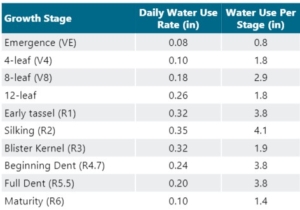
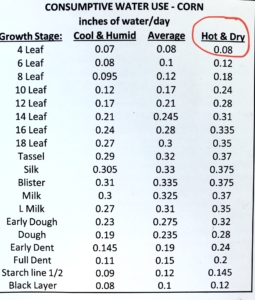
Things to keep in mind over the next weeks on irrigation management:
- Good idea to check to make sure your pivots are applying what the timer says it is. Being short .20-.30″ each circle adds up to a lot over the irrigation season. You want to catch this early…..
- Be ready to begin irrigation ‘season’ earlier this year due to the reduced soil moisture profile. We will need to start irrigating sooner to help ‘push’ water into the lower profile if no help from mother nature. This will be critical for pollination and grain-fill. Remember, the greatest impact yield loss from water stress occurs from two weeks before to two weeks after tassel.
- Keep in mind control hours on electric pivots, you may want to change control hours as the year progresses.
- Be prepared for wells to lose pressure over time in heavy irrigation periods. May want to check on acid supplies for acidizing wells later in the year.
- Check satellite imagery often starting now and through August to catch any sprinkler issues or water patterns in time for them to be corrected.
- Always keep safety in the forefront as you irrigate….take your time when around power boxes, motors, etc.
RAPID GROWTH SYNDROME IN CORN
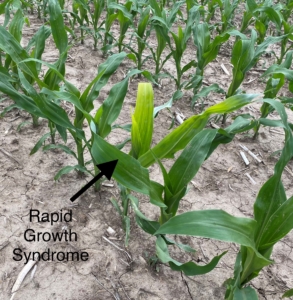
Rapid growth syndrome usually occurs when corn leaves fail to unfurl properly and the whorl becomes tightly wrapped and twisted. It is generally associated with an abrupt transition from cool temperature to warmer conditions. This syndrome usually occurs in the late V5 to early V6 stage, but can occur through and beyond V8-V9. Hybrids can also vary in there susceptibility to this. So far, we are not seeing much of this condition.
The Good News: Yield doesn’t seem to be affected by the twisted growth. Once the plant is chest high the only evidence that remains is the leaves can have a crinkled appearance….this is also the yellow leaf phenomenon.
Crop Focus: Rapid Growth
INSECT UPDATE:
Corn Rootworms –
It’s about that time to start seeing our annual rootworm hatch. When we see the cotton start to fly, or the famous lightning bugs, we will know rootworm hatch is underway because it takes about the same GDU’s (680-750 soil based degree days) for all of these things to happen.
Some fun facts:
- Larvae in sandy soils can become scratched and lacerated causing more mortality
- Flooded or saturated soils will cause more mortality
- Dry soil in late summer creates deep cracks for adult egg laying for better winter survival….which we had in 2022.
- CRW will go through 3 growth stages (Each last 7-10 days)
- 3rd Instar will create the most damage to corn roots
- Begin scouting continuous corn acres mid-to-end of next week and throughout the month of June.
There are many management practices that can help mitigate the risk of yield loss or lodging due to corn rootworm. The best recommended strategy is to rotate to soybeans. Overall pressure was much less in 2022, so hopefully, overall larvae populations are starting from low numbers. The new Vorceed Enlist technology from Pioneer will be a new ‘tool’ in the toolbox for CRW control for next year. Vorceed will offer three distinct modes of action for protection against CRW. More on this technology as the summer progresses.
Corn Rootworm: Scouting & Management Practices
European Corn Borer:
We have yet to see ECB moth flight. However, we should begin to see moth over the next two weeks with egg-laying taking place the third week of June most likely. For those of you who have conventional corn and/or popcorn, begin scouting for this pest the week of the 19th and beyond. We will keep everyone updated on this pest….
SOYBEAN UPDATE:
Per what seems to be the norm now, soybean emergence and growth has been slow. However, fields are starting to take off as of late. Heavier residue fields will continue to show some unevenness for the next few weeks. We are starting to hear of soybeans randomly dying in dryland corners or dryland fields. We have yet to take a look at these spots, but most likely is a result of the dry conditions….dry conditions leading to little moisture in the rootzone…greatly increased potential for herbicide carryover from prior year. Usually something like this does not have ‘one’ cause for its happening, but is a combination of stresses. We are not seeing much for insect activity currently…very little bean leaf beetle and very little painted lady larvae.
Herbicide Applications:
The next couple of weeks will see the great majority of post applications for Enlist and Xtend soybeans. Below are some attachments for BMP’s for Enlist along with nozzle recommendations and tank cleanout. Please monitor wind direction and speeds as you begin applications to limit off-target movement of herbicides….
2023 Enlist Best Management Practices
What are some important reminders that are good to keep in mind before applying POST herbicides?
- Impact of weed height
- Influence of temperature
- Significance of rainfast period
Each of these alone or in-combination can lead to lessor than expected performance.
Impact of Weed Height
Something to share that could easily get overlook is how much faster weeds grow per day in June than in April. As you know well, Palmer amaranth grows rapidly; much faster in June than April
- Data from University of Delaware on Palmer amaranth growth in 30 day period
- April 5th planting date – 2.5” up to 5”
- May 12th – 5” up to 10”
- June 12th – 10” up to 16”
- To learn more…https://extension.umd.edu/sites/extension.umd.edu/files/publications/FS-1192_ControlLargePalmerAmaranth_CommonRagweed_Soybean_or_Corn_feb2022_ada.pdf
- So how does the performance of Enlist One® herbicide + Liberty change with increasing weed height?
- Multi-state study funded by Corteva & BASF – Enlist One 2 pt + Liberty 32 oz
- 3-4” Palmer amaranth verses 6-8”
- 90% vs. 78%
- 3-4” Waterhemp verses 6-8”
- 98% vs. 82%
- 3-4” Palmer amaranth verses 6-8”
- Multi-state study funded by Corteva & BASF – Enlist One 2 pt + Liberty 32 oz
- Learn more about the importance of tank-mixing to optimize Palmer amaranth control
- Click to watch video…https://aaes.uada.edu/videos/2020-pigweed-size-influence-on-herbicides/
Influence of Temperature
Most research suggests weeds are best controlled when air temperatures are between 75-86F
So what happens when air temperatures are colder or hotter than ideal?
- Glufosinate performance declines under colder night/day temperatures
- Decreases basipetal (movement to base of leaf) translocation
- Best results with 68F night and 75F day temperatures
- Read more…https://www.jstor.org/stable/4046882
- Best results with 68F night and 75F day temperatures
- Decreases basipetal (movement to base of leaf) translocation
- Mesotrione performance declines with hotter day temperatures
- Under high temperature stress; reduced mesotrione translocation & faster metabolism by weeds
- Best results with 72.5F night and 90.5F day temperatures
- Under high temperature stress; reduced mesotrione translocation & faster metabolism by weeds
Significance of Rainfast Period
Many different factors are at play when determining the success or failure from an unanticipated rain shower; herbicide characteristics, adjuvant type, RH, temp., intensity of rain
Important to know as well, weed species will respond differently
- Glyphosate – rainfast period of 4 hours needed to control goosegrass and Palmer amaranth, while 24 hours needed for pitted morningglory
- Glufosinate – rainfast period of 1 hour was needed for goosegrass and pitted morningglory, while 24 hours was needed for Palmer amaranth
-
- Read on to learn more…https://repository.lib.ncsu.edu/bitstream/handle/1840.16/4809/etd.pdf?sequence=1
- Reference rainfast period for POST herbicides by clicking this link…https://www.canr.msu.edu/weeds/extension/weed-control-guide/2018WG-table-11.pdf
Thanks to Jason Gibson, Market Development Specialist, Corteva Crop Protection for the above info and tips!
Please reach out to us with any questions or concerns you may have over the next few weeks. Stay cool and stay safe! Thank you for all of your support!!
STARMAN SEED SERVICE, INC.

